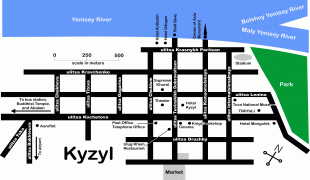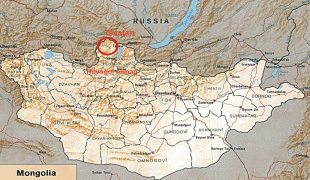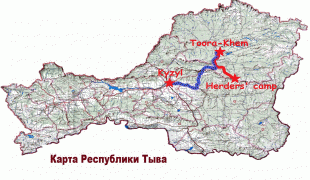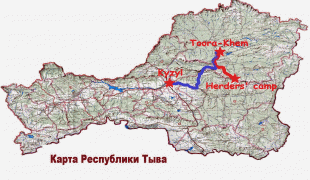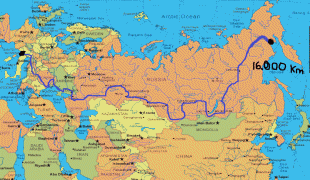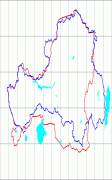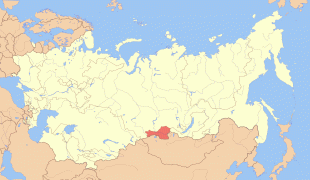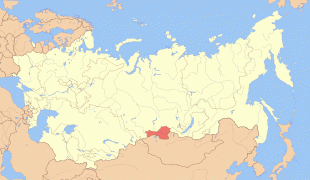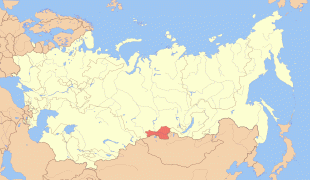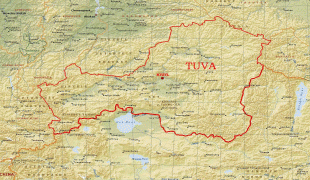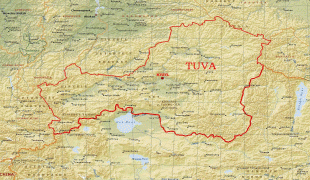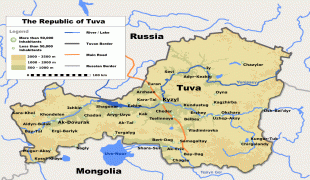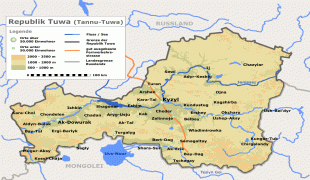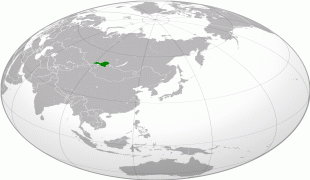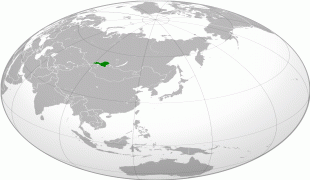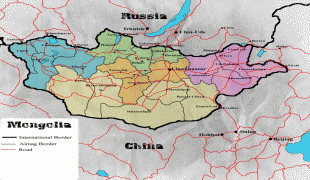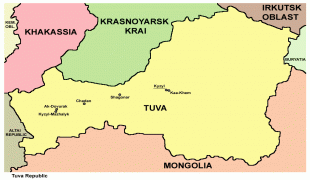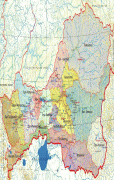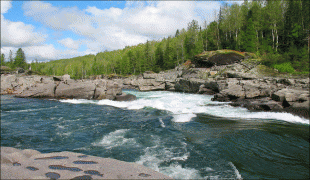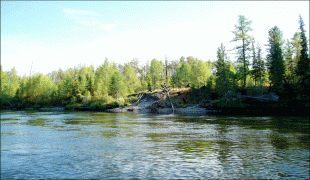Tuva (Respublika Tyva)
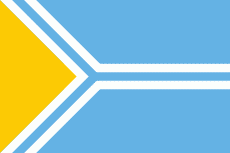 |
 |
The Tuvan Republic lies at the geographical center of Asia, in southern Siberia. The republic borders the Altai Republic, the Republic of Khakassia, Krasnoyarsk Krai, Irkutsk Oblast, and the Republic of Buryatia in Russia and Mongolia to the south. Tuva has a population of 336,651 (2021 census). Its capital is the city of Kyzyl.
Historically part of Outer Mongolia as Tannu Uriankhai during the Qing dynasty, the last imperial dynasty of China, Tuva broke away in 1911 as the Uryankhay Republic following the Xinhai Revolution, which created the Republic of China. It became a Russian protectorate in 1914 and was replaced by the nominally independent Tuvan People's Republic in 1921 (known officially as Tannu Tuva until 1926), recognized only by its neighbors the Soviet Union and Mongolia, before being annexed into the former in 1944. A majority of the population are ethnic Tuvans who speak Tuvan as their native tongue, while Russian is spoken natively by the Russian minority; both are official and widely understood in the republic. Its legislature is the Great Khural.
The territory of Tuva has been controlled by the Xiongnu Empire (209 BC – 93 AD) and the Xianbei state (93–234), Rouran Khaganate (330–555), the Yenisei Kyrgyz (7th – 13th century), Mongol Empire (1206–1271), Yuan dynasty (1271–1368), Northern Yuan dynasty (1368–1691), Khotgoid Khanate and Zunghar Khanate (1634–1758). Medieval Mongol tribes, including Oirats and Tumeds, inhabited areas which are now part of the Tuvan Republic.
From 1758 to 1911, Tuva was part of China's Qing dynasty and administered by Outer Mongolia. During the Xinhai Revolution in China, Tsarist Russia formed a separatist movement among the Tuvans while there were also pro-independence and pro-Mongol groups. Tsar Nicholas II agreed to the third petition by Tuva's leadership in 1912, establishing a protectorate over the then-independent state. Some Russians, such as merchants, travellers, and explorers, had already settled in Tuva at that time. Tuva became nominally independent as the Uryankhay Republic before being turned into a Russian protectorate as Uryankhay Krai under Tsar Nicholas II, on 17 April 1914.
A Tuvan capital was established, called Belotsarsk (Белоца́рск; literally, "(Town) of the White Tsar"). Meanwhile, in 1911, Mongolia became independent, though under Russian protection. Following the Russian Revolution of 1917 that ended the imperial autocracy, most of Tuva was occupied from 5 July 1918 to 15 July 1919 by Alexander Kolchak's White Russian troops. Pyotr Ivanovich Turchaninov was named governor of the territory. In the autumn of 1918, the southwestern part was occupied by Chinese troops and the southern part by Mongol troops led by Khatanbaatar Magsarjav.
From July 1919 to February 1920, the communist Red Army controlled Tuva but from 19 February 1920 to June 1921 it was occupied by China (governor was Yan Shichao [traditional, Wade–Giles transliteration: Yan Shi-ch'ao]). On 14 August 1921, the Bolsheviks established the Tuvan People's Republic, popularly called Tannu-Tuva. In 1926, the capital (Belotsarsk; Khem-Beldyr since 1918) was renamed Kyzyl, meaning "red". The Tuvan People's Republic was de jure an independent state between the World Wars. The state's ruler, Chairman Donduk Kuular, sought to strengthen ties with Mongolia and establish Buddhism as the state religion. This unsettled the Soviet Union, which orchestrated a coup carried out in 1929 by five young Tuvan graduates of Moscow's Communist University of the Toilers of the East.
In 1930, the pro-Soviet regime discarded the state's Mongol script in favor of a Latin alphabet designed for Tuva by Russian linguists. In 1943, Cyrillic script replaced Latin. Under the leadership of Party Secretary Salchak Toka, ethnic Russians were granted full citizenship rights and Buddhist and Mongol influences on the Tuvan state and society were systematically curtailed.
Tuva was annexed by the Soviet Union in 1944, with the approval of Tuva's Little Khural (parliament), but without a referendum on the issue. It became the Tuvan Autonomous Oblast, within the Russian Soviet Federative Socialist Republic, after the Soviet victory in World War II. Salchak Toka, leader of the Tuvan People's Revolutionary Party, was given the title of First Secretary of the Tuvan Communist Party and became the de facto ruler of Tuva until his death in 1973. The territory became the Tuvan Autonomous Soviet Socialist Republic on 10 October 1961.
In February 1990, the Tuvan Democratic Movement was founded by Kaadyr-ool Bicheldei, a philologist at the Kyzyl State Pedagogical Institute. The party aimed to provide jobs and housing (both in short supply), and improve the status of the Tuvan language and culture. Later in the year, there was a wave of attacks against Tuva's sizeable Russian community, including sniper attacks on trucks, and attacks on outlying settlements, with 168 murdered. Russian troops were eventually called in. Many Russians moved out of the republic during this period. Tuva has remained remote and difficult to access.
Map - Tuva (Respublika Tyva)
Map
Country - Russia
 |
 |
| Flag of Russia | |
The East Slavs emerged as a recognisable group in Europe between the 3rd and 8th centuries CE. The first East Slavic state, Kievan Rus', arose in the 9th century, and in 988, it adopted Orthodox Christianity from the Byzantine Empire. Rus' ultimately disintegrated, with the Grand Duchy of Moscow growing to become the Tsardom of Russia. By the early 18th century, Russia had vastly expanded through conquest, annexation, and the efforts of Russian explorers, developing into the Russian Empire, which remains the third-largest empire in history. However, with the Russian Revolution in 1917, Russia's monarchic rule was abolished and replaced by the Russian SFSR—the world's first constitutionally socialist state. Following the Russian Civil War, the Russian SFSR established the Soviet Union (with three other Soviet republics), within which it was the largest and principal constituent. At the expense of millions of lives, the Soviet Union underwent rapid industrialization in the 1930s, and later played a decisive role for the Allies of World War II by leading large-scale efforts on the Eastern Front. With the onset of the Cold War, it competed with the United States for global ideological influence; the Soviet era of the 20th century saw some of the most significant Russian technological achievements, including the first human-made satellite and the first human expedition into outer space.
Currency / Language
| ISO | Currency | Symbol | Significant figures |
|---|---|---|---|
| RUB | Russian ruble | ₽ | 2 |
| ISO | Language |
|---|---|
| CE | Chechen language |
| CV | Chuvash language |
| KV | Komi language |
| RU | Russian language |
| TT | Tatar language |






